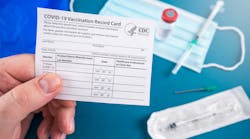Update: On Nov. 6, a federal appeals court in Louisiana temporarily blocked the mandate.
More details are emerging for more than 84 million workers who will be impacted by the Biden administration’s COVID-19 vaccination and testing requirements.
As part of the forthcoming Emergency Temporary Standard, employers with 100 or more employees (firm or company-wide) must develop, implement and enforce a mandatory COVID-19 vaccination policy. That is, unless employers adopt a policy where workers can choose to be vaccinated or submit to regular testing and wear a face covering at work.
The Occupational Safety and Health Administration (OSHA) announced that its ETS will be published in the Federal Register on Nov. 5 and will be effective immediately. Employers must comply with most requirements by Dec. 5, and they have until Jan. 4 to ensure their workers are fully vaccinated. Employers that fail to comply with the rule may be subject to fines.
“COVID-19 has had a devastating impact on workers, and we continue to see dangerous levels of cases,” said U.S. Labor Secretary Marty Walsh in a statement. “We must take action to implement this emergency temporary standard to contain the virus and protect people in the workplace against the grave danger of COVID-19. Many businesses understand the benefits of having their workers vaccinated against COVID-19, and we expect many will be pleased to see this OSHA rule go into effect.”
Publication of the ETS will likely mean that some employers may impose mandates now that there is more clarification from the government. Legal challenges to the vaccine mandate are also expected in the coming days, weeks and months, as there has already been vocal opposition and threats to sue from workers, companies, industries, unions, associations and states.
The ETS will cover two-thirds of the nation’s private-sector workforce. In the 26 states and two territories with OSHA State Plans, the ETS will also cover public sector workers who are employed by state and local governments, including educators and school staff.
OSHA estimates the ETS will save thousands of lives and prevent more than 250,000 hospitalizations due to workplace exposure to COVID-19.
The ETS will also require employers to take the following measures:
- Provide paid time off for workers to get vaccinated and paid leave for them to recover from any vaccine side effects.
- Determine the vaccination status of each worker, obtain acceptable proof from vaccinated employees, and maintain records and a roster of each worker’s vaccination status.
- Require workers to provide prompt notice if they test positive or receive a COVID-19 diagnosis. Employers must then remove those workers from the workplace, regardless of vaccination status. Employers may not allow them to return to the workplace until those workers meet required criteria.
- Ensure that workers who are not fully vaccinated are tested for COVID-19 at least weekly if they are at the workplace at least once a week or within 7 days before returning to work if the worker has been away from the workplace for at least a week. The ETS will require workers, in most instances, who have not been fully vaccinated to wear a face covering when indoors or when in a vehicle with another person for work purposes.
The ETS clarifies a question that employers and employment lawyers have been wondering since President Biden tasked OSHA with developing an ETS in his Sept. 9 televised address to the nation: costs. Under the ETS, employers will not be required to pay for face coverings nor COVID-19 testing. However, employers may be required to pay for testing to comply with other laws, regulations, collective bargaining agreements or other collectively negotiated agreements.
Having employees foot the bill for their testing didn't sit well with the National Council for Occupational Safety and Health (National COSH). “We’re glad to see this standard includes paid time off for workers to get a vaccine and recover from any side effects. But It’s very unfortunate that this new rule does not require employers to pay for face masks, or for the cost of testing for workers who choose not to get vaccinated,” said Jessica Martinez, co-executive director of National COSH, in a statement. “Pushing these costs onto workers is wrong-headed and an unprecedented departure from all previous OSHA standards. Employers, who have a responsibility to provide a safe workplace, have always been required to pay the costs of tests and screening for occupational illnesses and for personal protective equipment; this case should be no different."
OSHA will continue to monitor COVID-19 cases and deaths and will update the ETS as needed. The ETS will serve as a proposal for normal rulemaking for a final standard. OSHA is seeking comment on all aspects of the ETS and whether the agency should adopt it as final rule.
The Centers for Medicare & Medicaid Services also issued a ruling Nov. 4 that requires 17 million health care workers to be vaccinated by Jan. 4. There is no option for weekly testing. The rule covers clinical and non-clinical employees at health care facilities that receive either Medicare or Medicaid funding.
Biden previously announced vaccine requirements at the federal level. Federal workers have until Nov. 22 and workers at companies that receive federal contracts have until Jan. 4 to get vaccinated. There is no testing option.

